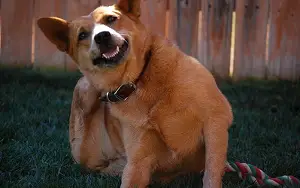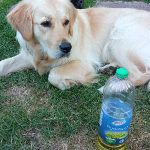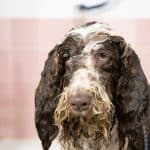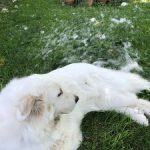
Apart from looking beautiful, a fundamental reason for sending our dogs off to be groomed is for their comfort.
Which is why, when they return from being groomed and they are clearly not comfortable, it is a bit upsetting to say the least.
After all, a complete grooming session in the U.S. will cost on average $51– although that will rise to nearly $60 in locations such as Maryland, Pennsylvania and Virginia.
So in many ways, you have good reason to be annoyed!
In this article, I want to focus on why some dogs return from a grooming session with a terrible itch.
There are several reasons why this might happen, which I will explain in detail in this article.
So, what are the main reasons?
Three Main Reasons That Dogs Might Itch After Grooming
There are many reasons why a dog may itch after grooming. Here are some of the most common:
Razor Burn
Razor burn is a common problem for most dogs and can happen with any grooming tool.
It occurs when the coat is cut too short or the blade is dull.
Razor burn looks like patches of redness on the coat, usually around the shoulders, belly, and back legs.
This often happens when you’ve clipped your dog too close to the skin, especially if they have a thick coat that needs trimming more often than usual.
It’s easy to spot because it will look like raw skin; no hair will grow in that area until the skin has healed.
You should always confirm with your vet first before shaving your dog, especially if he has sensitive skin or if you’re unsure how much fur should be removed.
Coarse Hairs Causing Friction
If your dog has coarse or curly hair, it can cause friction on its skin, leading to itching afterward.
This can happen if you shave your dog too short or use scissors instead of clippers when trimming their coat, both of these things will cause coarse hairs to rub against each other.
The friction from this rubbing can irritate your dog’s skin and make them start to scratch itself excessively as a way of relieving this irritation.
One way to help solve this problem is by using conditioner on your dog’s coat before bathing it or brushing it out; conditioner helps soften the coat and reduce friction between the skin and hair.
General Irritation
This can be caused by how you groom your dog or by an allergy or skin condition.
If you realize your dog has an upset stomach after being groomed, this could signify that your dog is allergic to something in the used shampoo or conditioner.
It’s important to remember that even with all-natural products, like Bark Butter, it’s still possible for your dog to have an allergic reaction.
If you realize your dog is itching after being bathed, try switching brands and see if this helps the problem.
If not, try using olive oil as a moisturizer instead of shampoo or conditioner until you find something that works well for both of you!
Four Quick Fixes The Dog Owner Can Do To Stop The Itching?
Yes! You can take plenty of steps at home to help your dog feel better. These may include:
Chamomile And Herbal Tea Soaks
Chamomile is a gentle, soothing herbal remedy for dogs with itchy skin.
Chamomile has anti-inflammatory properties and can reduce your dog’s discomfort. You can make a tea out of chamomile or purchase a chamomile spray or lotion at your local pet store.
Apple Cider Vinegar For Itchy Dogs
Apple cider vinegar is a natural remedy that may help reduce itching in dogs.
Apple cider vinegar contains malic acid, which has antibacterial and anti-fungal properties that help treat yeast infections in dogs.
You can give your dog two teaspoons of apple cider vinegar diluted in water several times daily to relieve itching caused by yeast infections.
Oatmeal Bath For Itchy Dogs
An oatmeal bath is an excellent option for dogs suffering from skin allergies.
The best way to do this is by boiling water and adding a cup of rolled oats.
Let the oats steep for 10 minutes before draining the water and pouring it into a tub of lukewarm water.
Gently rub the oatmeal all over your dog, paying special attention to his belly, ears, and paws.
If your dog isn’t comfortable with this treatment, try rubbing the oatmeal into his coat instead.
Sugar-Free Plain Yogurt
Plain yogurt has probiotics that help keep your dog’s digestive tract healthy.
The probiotics also help boost their immune system and may help reduce the amount of yeast in their system, which causes them to itch more often than usual.
Suppose you want to give this as an alternative to giving them antibiotics every time they start itching again.
You could try giving them plain yogurt instead of antibiotics every day for several weeks until the itching stops completely or significantly decreases.
What are the main areas on the body that a dog might itch?
A dog may itch in many areas of his body. The most common areas include:
Face
Dogs with dry noses and skin may be allergic to dust mites.
If you see your dog rubbing its face on the floor or furniture, it probably has an allergy problem.
Belly
Allergies can cause hives on a dog’s belly.
These hives look like small red bumps, usually round or oval.
You might notice that your dog has hives only when it scratches itself in some regions of its body, and this could indicate that the dog has fleas or some other condition that causes itching under your dog’s skin, such as mange.
Paws
If you use brushes or combs on your dog’s paws and legs, he’ll probably shake his feet afterward. This is normal behavior, but some dogs will scratch their paws later.
If this happens, try using a different type of brush or comb.
Apart From Itching, What Other Behaviors Might A Dog “Show” Indicate That They Are Uncomfortable After A Grooming Session?
A dog who is uncomfortable with its grooming experience may show a variety of behaviors, including:
Signs Of Aggression
Some dogs will show signs of aggression when uncomfortable after being groomed.
This could be anything from growling at you when you try to touch them in certain areas, biting you, or even biting other animals around them, especially other dogs.
Other dogs might become withdrawn around their owner and not want any human contact; this is especially common among smaller breeds.
Panting And Drooling
Panting and drooling are usually associated with pain, but they may also be due to anxiety or fear.
If your dog shows these signs after grooming sessions, try to find out what happened during the process that might have caused them to become anxious or afraid.
Sometimes, this may involve a bad experience with you or another person while being groomed, such as being forced into an uncomfortable position by pulling on their legs or tail, which can make them fearful of future grooming sessions.
Could Your Dog Be Allergic To One Of The Products Used By The Groomer?
The ingredients in shampoos can vary widely; some common ones are listed below.
It’s important to note that these are not exhaustive lists but a sampling of some of the most common ingredients in pet shampoos.
Some examples of common shampoo ingredients include:
Sodium Lauryl Sulfate (SLS)
This ingredient acts as a defoamer in many products, including shampoos. It can cause skin irritation in dogs, but it’s typically not a problem unless they have susceptible skin or use the product daily. If your dog has been getting regular baths with SLS and suddenly starts having itching problems after his last bath, this might be what happened. If so, try switching to a different brand of shampoo with fewer chemicals, or better yet, try washing him only once every week or two with water and no soap. The less frequently you bathe your dog, the less likely he will have problems with SLS-related irritation.
Propylene Glycol
This ingredient helps keep the product from freezing during shipment or storage. Still, it can also cause skin irritation if used too frequently or in conjunction with other propylene glycol products.
Conditioners
Conditioners help to detangle fur and make it shiny and soft, and they also help prevent matting and tangling, which can lead to more breakage and shedding. The most common conditioner ingredients are silicone and mineral oil, which can irritate some dogs if applied too often.
Supposing That The Itching Wasn’t Caused By The Grooming? What Are The Main Reasons That Dogs Itch?
There are several causes of itching in dogs, but the main one is Parasitic Bites; Fleas and ticks are the most common parasitic bites that cause itching in dogs. Flea allergies can also cause severe skin irritation and hair loss. Some breeds of dogs are more susceptible to flea bites than others, but any dog can be affected.
Ticks carry many diseases, including Lyme disease and Rocky Mountain spotted fever. Most tick bites do not cause significant skin irritation or hair loss, but they can be very painful when they attach themselves to your dog’s skin. If you notice a tick on your dog, remove it carefully by grasping the tick with tweezers as close to the skin as possible and pulling straight up with steady pressure until the tick releases its grasp on the dog’s skin. Never use petroleum jelly or any other substance for removal; these products make it easier for ticks to remain attached.
Other causes of itching include:
- Allergies
- Skin infections
Can You Groom Your Dog?
Yes! You can groom your dog, but you need to be prepared. Grooming your dog is a rewarding experience, and it can save you money and help you bond with your pet. If you’ve ever brushed or combed your pet, then grooming won’t be a problem for you. Most dogs are easy to handle and only need essential grooming every few months.
The equipment cost will vary depending on what type of grooming you do and how many tools you need. For example, if you wash and blow dry a small breed dog, you only need shampoo and a brush or two. However, if you plan on giving large breed dogs a full bath and cutting their hair into a style that works with their coat type and length, then you’ll need more stuff than just shampoo and a brush!
If your pet is a short-hair breed, all you need is a brush and comb. The medium-length coat may require scissors and clippers, and Long-haired dogs usually require more supplies because they shed heavily during shedding season. The costs of this equipment can range from $11-$23
It takes about 6 to 10 weeks to train as a dog groomer. You must complete an apprenticeship program, which involves working under the supervision of a certified master groomer.
Once you’ve completed your training, you must pass a state examination before becoming licensed.
Conclusion
Since your dog’s skin is soft, warm, and slightly oily, many organisms can infect it. Several different types of bacteria and yeast are the likeliest culprits for canine “itchy bumps” on their skin after being groomed. The first thing to do would be to bring your dog to a vet to check her out and ensure that this isn’t an active infection. After that, however, many dogs can simply be treated at home with a special anti-fungal shampoo – or you can try washing them down with dish soap.
Photo credits
¹ Photo by Donnie Ray Jones on Flicker




